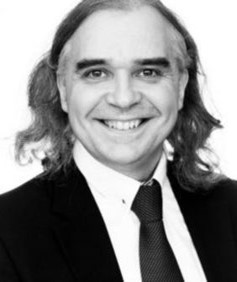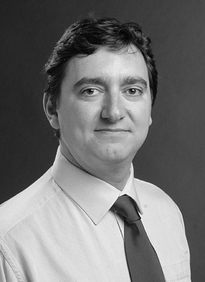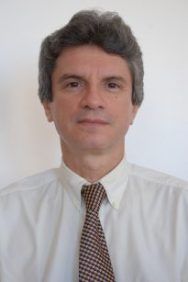
Josep M. Guerrero
Josep M. Guerrero

Sobre Josep
received the B.S. degree in telecommunications engineering, the M.S. degree in electronics engineering, and the Ph.D. degree in power electronics from the Technical University of Catalonia, Barcelona, in 1997, 2000 and 2003, respectively. Since 2011, he has been a Full Professor with the Department of Energy Technology, Aalborg University, Denmark, where he is responsible for the Microgrid Research Program (www.microgrids.et.aau.dk). From 2014 he is chair Professor in Shandong University; from 2015 he is a distinguished guest Professor in Hunan University; and from 2016 he is a visiting professor fellow at Aston University, UK, and a guest Professor at the Nanjing University of Posts and Telecommunications. From 2019, he became a Villum Investigator by The Villum Fonden, which supports the Centre for Research on Microgrids (CROM) at Aalborg University, being Prof. Guerrero the founder and Director of the same centre.
His research interests is oriented to different microgrid aspects, including power electronics, distributed energy-storage systems, hierarchical and cooperative control, energy management systems, smart metering and the internet of things for AC/DC microgrid clusters and islanded minigrids. Specially focused on maritime microgrids for electrical ships, vessels, ferries and seaports. Prof. Guerrero is an Associate Editor for a number of IEEE TRANSACTIONS. He has published more than 500 journal papers in the fields of microgrids and renewable energy systems, which are cited more than 40,000 times. He received the best paper award of the IEEE Transactions on Energy Conversion for the period 2014-2015, and the best paper prize of IEEE-PES in 2015. As well, he received the best paper award of the Journal of Power Electronics in 2016. During six consecutive years, from 2014 to 2019, he was awarded by Clarivate Analytics (former Thomson Reuters) as Highly Cited Researcher. In 2015 he was elevated as IEEE Fellow for his contributions on “distributed power systems and microgrids." ⠀⠀⠀⠀⠀⠀⠀⠀⠀⠀⠀⠀⠀⠀⠀⠀⠀⠀⠀⠀⠀⠀⠀⠀⠀⠀⠀⠀⠀⠀⠀⠀⠀⠀⠀⠀⠀⠀⠀⠀⠀⠀⠀⠀⠀⠀⠀⠀⠀⠀⠀⠀⠀⠀⠀⠀⠀⠀⠀⠀⠀⠀⠀⠀⠀⠀⠀⠀⠀⠀⠀⠀⠀⠀⠀⠀⠀⠀⠀⠀⠀⠀⠀⠀⠀⠀⠀⠀⠀⠀⠀⠀⠀⠀⠀⠀⠀⠀⠀⠀⠀⠀⠀⠀⠀⠀⠀⠀⠀⠀⠀⠀⠀⠀⠀⠀⠀⠀⠀⠀⠀⠀⠀⠀⠀⠀⠀⠀⠀⠀⠀⠀⠀⠀⠀⠀⠀⠀⠀⠀⠀⠀⠀⠀⠀⠀⠀⠀⠀⠀⠀⠀⠀⠀⠀⠀⠀⠀⠀⠀⠀⠀⠀⠀⠀⠀⠀⠀⠀⠀⠀⠀⠀⠀⠀⠀⠀Microgrids Technologies for Land, Maritime and Aerospace Applications Josep M. Guerrero, Fellow, IEEE
Summary - A microgrid is an electrical distribution network consisted of distributed generators, local loads, and energy storage systems that can operate in grid-connected or islanded modes. Different technologies are combined together, such us power converters, control, communications, optimization, and so on. This way the energy can be generated and stored near to the consumption points, improving the stability and reducing the losses produced by the large power lines. In distributed energy systems like microgrids, multi-agent systems technologies will be presented distributed control is a powerful tool for distributed. In this talk examples of research and projects in real sites including conventional islanded systems installed in islands and rural remote areas, low-voltage distribution systems and AC and DC microgrids for residential applications and homes electrical vehicle charging stations, ships, vessels, and ferries, and seaports will be shown. Finally aerospace applications will be shown, including aircrafts and nanosatellites.
Federico Milano
Federico Milano

Sobre Federico
Federico Milano received from the University of Genoa, Italy, the ME and PhD in Electrical Engineering in 1999 and 2003, respectively. From 2001 to 2002 he was with the University of Waterloo, Canada, as a Visiting Scholar. From 2003 to 2013, he was with the University of Castilla-La Mancha, Spain. In 2013, he joined the University College Dublin, Ireland, where he is currently Professor of Power Systems Control and Protections and Head of Electrical Engineering. He has authored and co-authored 6 books and over 200 papers. He was elevated to IEEE Fellow in 2016 for his contributions to power system modeling and simulation, and to IET Fellow in 2017. He is or has been an editor of several international journals published by IEEE, IET, Elsevier and Springer, including the IEEE Transactions of Power Systems and the IET Generation, Transmission \& Distribution. He is also an IEEE PES Distinguished Lecturer, since 2020. ⠀⠀⠀⠀⠀⠀⠀⠀⠀⠀⠀⠀⠀⠀⠀⠀⠀⠀⠀⠀⠀⠀⠀⠀⠀⠀⠀⠀⠀⠀⠀⠀⠀⠀⠀⠀⠀⠀⠀⠀⠀⠀⠀⠀⠀⠀⠀⠀⠀⠀⠀⠀
Frequency Variations in Power Systems: A theoretical framework for low inertia systems
Abstract: The conventional power system model for transient stability analysis is based on the assumption of quasi-steady-state phasors for voltages and currents. The crucial hypothesis on which such a model is defined is that the frequency required to define all phasors and system parameters is constant and equal to its nominal value. This model is appropriate as long as only synchronous machines regulate the system frequency through standard primary and secondary frequency regulators. In recent years, however, an increasing number of devices other than synchronous machines are expected to provide frequency regulation. These include, among others, distributed energy resources such as wind and solar. However, these devices do not generally impose the frequency at their connection point with the grid. There is thus, from a modeling point of view, the need to define with accuracy the local frequency at every bus of the network.
The presentation is divided into three parts. The first part presents an accurate yet simple and computationally inexpensive formula, namely, the frequency divider, to estimate such frequencies and, thus, improve the fidelity of the conventional power system model for transient stability analysis. The second part focuses on relevant applications of the frequency divider, namely, the estimation of the rotor speeds of synchronous machines and of the center of inertia by means of phasor measurement units as well as the determination of participation factors of synchronous machines to local bus frequency variations. Finally, the third part extends the estimation problem to non-synchronous devices and provides a novel interpretation of the rate of change of power injected at a bus. A practical definition of devices that impact on the frequency at their point of connection, namely frequency influencers, is proposed. Relevant applications to the estimation of the parameters of voltage-dependent loads as well as the location of forced oscillations are outlined. The results of several case studies serve to illustrate the behaviour of the frequency divider formula as well as the robustness against noise and bad data of the estimation of machine rotor speeds and the utilization of the concept of frequency influencer to identify non-synchronous devices that provide fast frequency response to the system.

Saulo J. N. Cisneiros
Saulo J. N. Cisneiros

Sobre Saulo
Graduou-se em engenharia elétrica em 1973 pela Escola de Engenharia da UFPE. Pós graduou-se em 1978 em engenharia de sistemas elétricos pela Escola Federal de Engenharia de Itajubá. Iniciou sua carreira na CHESF em 1972 onde exerceu várias funções e cargos e desligou-se em 1998, como Superintendente de Operação e Comercialização de Energia. Na ELETROBRÁS foi Gerente do Centro Nacional de Operação de Sistemas e Diretor de Projetos Especiais. Foi membro do Conselho de Administração de diversas empresas do setor elétrico. No ONS foi Gerente Executivo de quatro áreas, esteve como Assistente Executivo da Diretoria de Planejamento e Programação da Operação e desligou-se em 2019 como Representante Regional Norte/Nordeste em Recife. É Sócio-Diretor da empresa SJNC – Consultoria e Engenharia de Energia Ltda. É “Distinguished Member” do CIGRÉ, foi “Special Reporter” na Sessão Bienal de 2006 em Paris e recebeu o “Technical Committee Award” neste mesmo ano. É sócio honorário do CIGRE-Brasil, foi 2º Vice-Presidente, Diretor Técnico e está como Presidente do CIGRE-Brasil. Coordenou diversos grupos de trabalho no âmbito do setor elétrico e publicou mais de 60 artigos em seminários e revistas nacionais e mundiais.Importância das Energias Renováveis para os Países em Desenvolvimento
As fontes renováveis trazem inúmeros benefícios que a tornam fontes de energia atraentes, sobretudo a Eólica e Solar, cujos principais benefícios são:- Energia limpa e inesgotável – após a sua instalação, as energias renováveis não produzem qualquer tipo de emissões e não se esgotam ao longo do tempo;
- Tecnologia modular e escalonável – essas fontes podem tomar diversas formas, incluindo grandes centrais, produção distribuída e sistemas para uso final;
- Estabilidade do preço da energia – ao colaborar na diversificação do mix energético, as energias renováveis reduzem a dependência aos combustíveis convencionais, reduzindo a volatilidade dos preços de oferta de energia em mercado;
- Redução da dependência de combustíveis importados: os custos das energias renováveis não resultam da importação do combustível, reduzindo assim a dependência energética e econômica do exterior e aumentando a segurança do abastecimento de energia;
- Desenvolvimento econômico local – os parques eólicos e solares podem fornecer um fluxo financeiro estável para os investidores nestas centrais e também para os proprietários locais que alugam os seus terrenos para a implementação das turbinas eólicas que, consequentemente, também aumentam as receitas fiscais das propriedades para as comunidades locais, promovendo geração de emprego e renda, sobretudo nos países em desenvolvimento.
Palestrantes

Josep M. Guerrero

Federico Milano

Saulo J. N. Cisneiros














